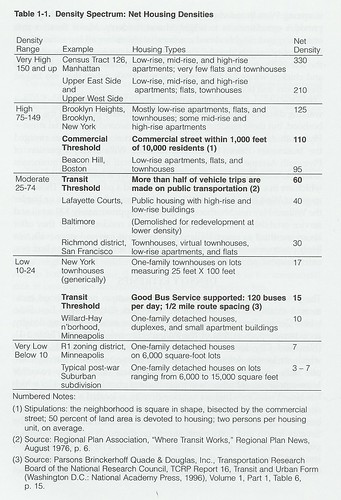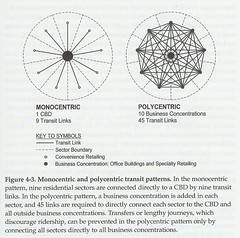Transit as a way of life vs. a way to get to work
"In spite of the need to move urban traffic, many urban highway programs have been stalemated for one reason or another. In Washington, DC there has been an effective, organized citywide drive to curtail highway construction. The Washington program includes an Inner Loop Freeway which would serve the purpose of bypassing through automobile traffic and permit the citizens who live in the outlying areas to have greater accessiblity to the downtown area. The opponents of this program have succeeded in persuading Congress to hold in abeyance the necessary appropriations until a study regarding the need for a subway and rapid rail transit system is completed. Such a program for Washington, DC, is obviously not feasible from an economic point of view and would servce no useful purpose. Metropolitan Washington is a 'lateral' area. As a result, there is little, if any, heavy concentration of people in a given suburban area. If they were to use such a rapid transit system they would be requited to drive considerable distances to the pick-up stations... states that motorists would continue to shun public transit if they were paid to ride it."
-- Executive Director's Report by William C. Barr, Parking (the journal of the National Parking Association), Fall 1962, p. 9 .
Ironically, this was published about 7 months after the streetcar system was abandoned as a result of an order by Congress, in legislation passed in the 1950s.
This weekend DC1974 sent me a link to a piece on the light rail system in San Jose, "Roadshow tracks the trolley: Light rail has grown in 20 years," from the San Jose Mercury News. He makes the point that it is an extensive system, but that it doesn't have much in the way of substantive ridership--fewer than 40,000 daily riders, in large part because it is commuter focused, not compact development focused.
DC has resurged because in the core of the city, with Van Ness and Brookland on the north, Foggy Bottom on the west, and Stadium-Armory on the east, there are 29 subway stations in about 15 square miles.

Subway stations at the core of the city of Washington.
Similarly, Arlington is resurging because of how they are redeveloping the county around transit.

Steve Belmont discusses the importance of recentralizing commerce, housing, and transportation, in the book Cities in Full. Interestingly, there is a piece in last week's Financial Times, about Fred Smith and the creation of FedEx. He makes the point that using linear programming, network planning, and agglomeration economies (not his words), that the overall system can be optimized by the hub and spoke system that they created. See "The man who reinvented the wheel."
I was thinking that this is the same argument for compact development. Overall efficiency is optimized, even if certain trips, considered only on their own terms, are less efficient.

From Cities in Full.
But if your transit "system" is oriented to bringing in suburban commuters to jobs in the city, the system isn't likely to have the kind of transformative impact that the subway system is finally having in DC.
It's about transit for getting to work vs. transit as part of your way of life. As Steve writes:
I just walk down tree-lined townhouse-filled 19th Street to get to work and back. It's about 30 minutes if I don't stop at Kramerbooks or make a detour to Whole Foods.

Belmont is critical of the WMATA system as being polycentric and commuter oriented. He's right, but because of the density of stations at the core of Washington, Washington itself has a monocentric section of the subway system, akin to how BART in the SF Bay region is the commuter railroad, while the (overburdened) MUNI System within SF focuses on getting people around within San Francisco is a "relatively" efficient manner.

The Development-Related Ridership Survey by WMATA found that within 1/2 mile of Metro stations, the total transit use for residents ranged from 36% of all trips (1/2 mile away) to 55% (0 miles away), and for work trips, the use of transit ranged from 13% (1/2 mile away) to 46% (0 miles away). Note that many of the catchment areas studied were in the suburbs, in-city compactly developed areas show the highest numbers.
Labels: land use planning, sutainable land use and resource planning, transit oriented development, transportation planning



0 Comments:
Post a Comment
<< Home